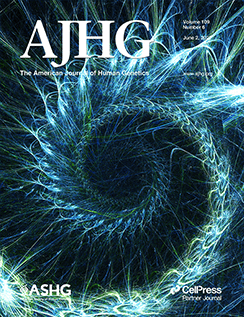利用本地祖先和跨祖先遗传结构来改进混合群体复杂性状的遗传预测。
IF 8.1
1区 生物学
Q1 GENETICS & HEREDITY
引用次数: 0
摘要
多基因风险评分(PRS)在欧洲人向非欧洲人群的可移植性有限,阻碍了多基因风险评分的广泛应用。虽然已经开发了许多统计方法来提高非欧洲人群的PRS性能,但大多数方法都集中在离散遗传祖先集群上,而没有考虑混合个体。由于本地祖先和交叉祖先效应量的复杂性,混合个体对PRS计算提出了独特的挑战。在这里,我们提出了一种称为SDPR_admix的统计方法来计算混合个体的PRS。SDPR_admix表征了两个祖先的遗传变异效应大小的联合分布为零,祖先丰富或具有相关性。当使用基因组学和流行病学(PAGE)数据集(N = 13,000)进行人口结构训练时,SDPR_admix在模拟中优于其他方法,并改进了对英国生物银行欧洲-非洲混合个体真实特征的预测。与在PAGE上训练相比,在All of Us (N = 52,000)上部署SDPR_admix进一步将预测精度平均提高了约5倍。这种增强是在可管理的计算时间和成本下实现的,证明了在大规模All of Us数据上训练PRS模型的可行性。我们提供了几个例子来证明,包括在SDPR_admix预测模型中的祖先富集效应和共享效应都有助于提高混合群体的多基因预测。我们还应用SDPR_admix构建了具有欧洲和美洲原住民混合血统的混合美国人的PRS,结果表明SDPR_admix总体上优于其他方法。本文章由计算机程序翻译,如有差异,请以英文原文为准。
Leveraging local ancestry and cross-ancestry genetic architecture to improve genetic prediction of complex traits in admixed populations.
The broader application of polygenic risk score (PRS) is hindered by the limited transferability of PRS developed in Europeans to non-European populations. While many statistical methods have been developed to improve the performance of PRS in non-European populations, most of them focused on discrete genetic ancestry clusters and did not consider admixed individuals. Admixed individuals pose a unique challenge for PRS calculation due to the complexity of local ancestry and cross-ancestry effect sizes. Here, we present a statistical method called SDPR_admix for calculating PRS in admixed individuals. SDPR_admix characterizes the joint distribution of the effect sizes of a genetic variant with two ancestries to be both zero, ancestry enriched, or shared with correlation. SDPR_admix outperformed other methods in simulations and improved the prediction of real traits in European-African admixed individuals in UK Biobank when trained on the Population Architecture using Genomics and Epidemiology (PAGE) dataset (N = 13,000). Deployment of SDPR_admix on All of Us (N = 52,000) further increased the prediction accuracy by approximately 5-fold on average compared with training on PAGE. This enhancement was achieved with manageable computational time and cost, demonstrating the feasibility of training PRS models on large-scale All of Us data. We provided several examples demonstrating that both ancestral-enriched and shared effects, as included in the SDPR_admix prediction model, are helpful for improving polygenic prediction in admixed populations. We also applied SDPR_admix to construct PRS for admixed Americans with mixture of European and Amerindigenous ancestries and showed that SDPR_admix overall outperformed other methods.
求助全文
通过发布文献求助,成功后即可免费获取论文全文。
去求助
来源期刊
CiteScore
14.70
自引率
4.10%
发文量
185
审稿时长
1 months
期刊介绍:
The American Journal of Human Genetics (AJHG) is a monthly journal published by Cell Press, chosen by The American Society of Human Genetics (ASHG) as its premier publication starting from January 2008. AJHG represents Cell Press's first society-owned journal, and both ASHG and Cell Press anticipate significant synergies between AJHG content and that of other Cell Press titles.

 求助内容:
求助内容: 应助结果提醒方式:
应助结果提醒方式:


